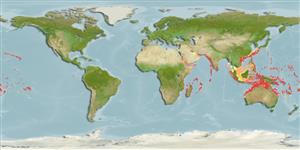Environment: milieu / climate zone / depth range / distribution range
Écologie
marin récifal; profondeur 20 - 220 m (Ref. 5222). Tropical; 36°N - 27°S, 37°E - 143°W (Ref. 5222)
Indo-Pacific: islands in tropical and subtropical waters from the western Indian Ocean to Jarvis Island (Line Islands, Kiribati) and French Polynesia (Ref. 4787), including Bassas da India (Mozambique Channel) (Ref. 5222).
Taille / Poids / Âge
Maturity: Lm ? range ? - ? cm
Max length : 50.0 cm TL mâle / non sexé; (Ref. 5222); common length : 30.0 cm TL mâle / non sexé; (Ref. 9137); poids max. publié: 2.0 kg (Ref. 5222)
Épines dorsales (Total) : 11; Rayons mous dorsaux (Total) : 16 - 17; Épines anales: 3; Rayons mous anaux: 8. Similar to E. fasciatus, differing primarily by having straighter head profile and longer snout, red rather than black tips on spinous dorsal fin (Ref. 37816). Distinguished by the following characteristics: adults dull yellowish orange to brownish red, each scale on the dorsolateral part of the body with dark greenish grey spot; usually 5 faint dark bares on body, 2nd and 3rd bars extend onto the spinous dorsal fin where they are dark brown; dorsal fin greenish brown, soft rayed part darker than rest of the fin, outer triangular part of interspinous membranes dark red, set off from the rest of the fin by an orange-yellow stripe; dark greenish brown dorsal fin margin of caudal fin; dark red or brown line along base of dorsal fin; narrowly edged orbit, except anteriorly, with dark red; pale blue line adjacent to the red rim of the orbit and completely surrounding eye; body depth contained 2.5-3.1 times in SL; head length 2.4-2.6 times in SL; flat to slightly convex interorbital, dorsal head profile slightly convex; rounded preopercle, finely serrate; sinuous upper edge of operculum; snout length 3.5-3.9 times in HL; subequal anterior and posterior nostrils; maxilla reaches below rear half of eye; 3-4 rows of teeth on midlateral part of lower jaw; pair of short fixed canines at front of both jaws; numerous pyloric caeca (Ref. 89707).
Adults are found in depths of 70 to 220 m on outer reef slopes; the young in depths of 20 to 40 m (Ref. 89707). Also caught with vertical longlines.
Life cycle and mating behavior
Maturities | Reproduction | Spawnings | Egg(s) | Fecundities | Larves
Heemstra, P.C. and J.E. Randall, 1993. FAO Species Catalogue. Vol. 16. Groupers of the world (family Serranidae, subfamily Epinephelinae). An annotated and illustrated catalogue of the grouper, rockcod, hind, coral grouper and lyretail species known to date. Rome: FAO. FAO Fish. Synop. 125(16):382 p. (Ref. 5222)
Statut dans la liste rouge de l'IUCN (Ref. 130435)
Menace pour l'homme
Harmless
Utilisations par l'homme
Pêcheries: pêcheries vivrières; pêche sportive: oui
Outils
Articles particuliers
Télécharger en XML
Sources Internet
Estimates based on models
Preferred temperature (Ref.
123201): 20.8 - 28.1, mean 26.1 °C (based on 472 cells).
Phylogenetic diversity index (Ref.
82804): PD
50 = 0.5000 [Uniqueness, from 0.5 = low to 2.0 = high].
Bayesian length-weight: a=0.01175 (0.00571 - 0.02419), b=3.04 (2.88 - 3.20), in cm total length, based on LWR estimates for this Genus-body shape (Ref.
93245).
Niveau trophique (Ref.
69278): 4.0 ±0.65 se; based on food items.
Résilience (Ref.
120179): Milieu, temps minimum de doublement de population : 1,4 à 4,4 années (Preliminary K or Fecundity.).
Fishing Vulnerability (Ref.
59153): Moderate vulnerability (40 of 100).
Nutrients (Ref.
124155): Calcium = 26.1 [12.5, 54.2] mg/100g; Iron = 0.474 [0.256, 0.953] mg/100g; Protein = 18.5 [16.9, 19.9] %; Omega3 = 0.142 [0.090, 0.227] g/100g; Selenium = 44.3 [26.0, 76.1] μg/100g; VitaminA = 188 [55, 660] μg/100g; Zinc = 1.21 [0.85, 1.69] mg/100g (wet weight);
